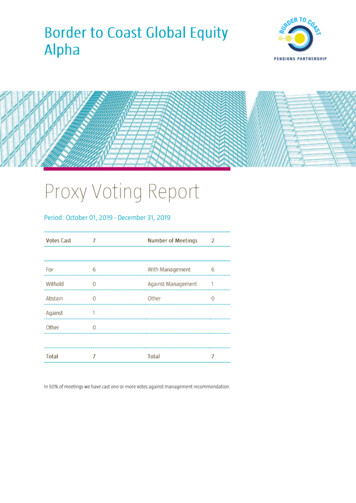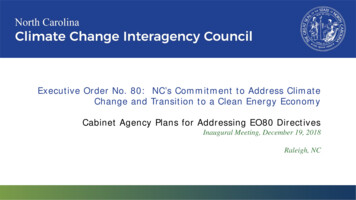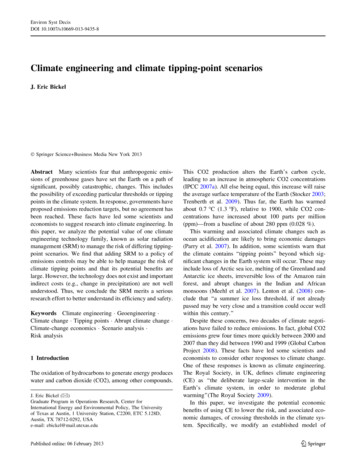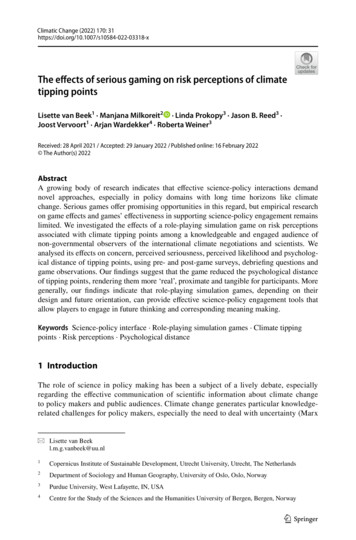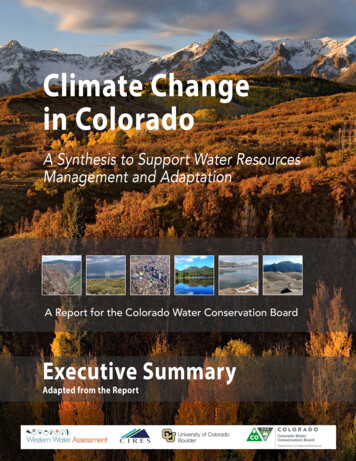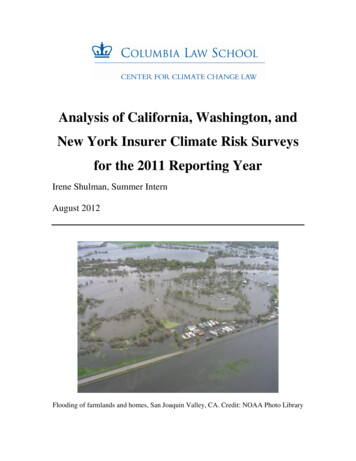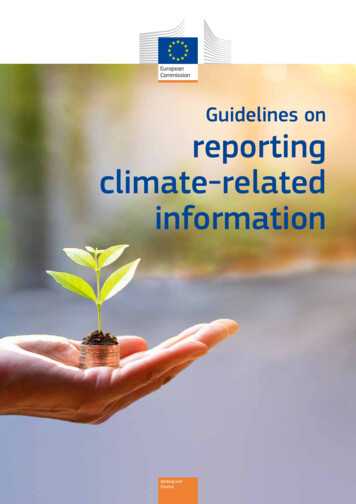
Transcription
Guidelines onreportingclimate-relatedinformationBanking andFinance
An interactive version of this publication, containing links to online content, is available inPDF format related-information-reporting-guidelines enGuidelines on reporting climate-related informationscan QR code to downloadEuropean CommissionDirectorate-General for Financial Stability, Financial Services and Capital Markets UnionEuropean Commission1049 Bruxelles/BrusselBelgium European Union, 2019Reproduction is authorised provided the source is acknowledged. For any use orreproduction of individual photos, permission must be sought directly from thecopyright holders.CREDITSAll images European Union, except:cover: Fotolia
EUROPEANCOMMISSIONBrussels, 17.6.2019C(2019) 4490 finalCOMMUNICATION FROM THE COMMISSIONGuidelines on non-financial reporting:Supplement on reporting climate-related informationENEN
Important noticeThis communication has been prepared pursuant to Article 2 of Directive 2014/95/EU inorder to assist companies concerned to disclose non-financial information in a relevant,useful, consistent and more comparable manner. It is a supplement to the Guidelines onNon-Financial Reporting adopted by the Commission in 2017 (C(2017)4234 final). Thiscommunication provides non-binding guidelines, and does not create new legal obligations.To the extent that this communication may interpret Directive 2014/95/EU, theCommission's position is without prejudice to any interpretation of this Directive that maybe issued by the Court of Justice of the European Union. Companies using these guidelinesmay also rely on international, EU-based or national frameworks. This communication doesnot constitute a technical standard, and neither preparers of non-financial statements nor anyparty, whether acting on behalf of a preparer or otherwise, may claim that non-financialstatements are in conformity with this document.1
Contents12Introduction . 31.1Why provide new guidelines on climate-related disclosures? . 31.2Benefits for reporting companies . 4How to use these guidelines . 52.1General considerations . 52.2Materiality . 62.3Climate-related risks, dependencies, and opportunities . 82.4Structure of the proposed disclosures. 112.5Consistency with recognised reporting frameworks and standards . 12Recommended disclosures and further guidance . 1233.1Business Model . 123.2Policies and Due Diligence Processes . 133.3Outcomes. 153.4Principal Risks and their Management. 153.5Key Performance Indicators . 17Annex I: Further guidance for banks and insurance companies . 26Annex II: Mapping of Non-Financial Reporting Directive Requirements and TCFDRecommended Disclosures . 352
1Introduction1.1Why provide new guidelines on climate-related disclosures?The 2015 Paris Agreement on Climate Change, the United Nations’ Sustainable DevelopmentGoals and the Special Report of the Intergovernmental Panel on Climate Change (October2018) all call for accelerated and decisive action to reduce greenhouse gas (GHG) emissionsand to create a low-carbon and climate-resilient economy. The EU has agreed ambitioustargets for 2030 regarding GHG emission reductions, renewable energy and energyefficiency1, and has approved rules on GHG emissions from land use as well as emissionstargets for cars and vans. In 2018 the Commission published its strategic long-term vision fora prosperous, modern, competitive and climate-neutral economy by 2050.2Companies and financial institutions have a critical role to play in the transition to a lowcarbon and climate-resilient economy. Firstly, an additional annual investment of 180billion is already needed to meet the EU’s energy and climate 2030 targets, and further fundswill be needed to achieve climate neutrality by 2050. Many of these investments representsignificant business opportunities, and much of the funding will need to come from privatecapital. Secondly, companies and financial institutions need to better understand and addressthe risks of a negative impact on the climate resulting from their business activities, as well asthe risks that climate change poses to their business. Weather-related disasters caused arecord 283 billion in economic damages in 2017 and could affect up to two-thirds of theEuropean population by 2100 compared with 5% today. Better disclosure of climate relatedinformation by companies can contribute to the implementation of the Sendai Framework forDisaster Risk Reduction 2015-2030, which calls for governments to evaluate, record, shareand publically account for disaster losses.In March 2018 the Commission published the Action Plan on Financing Sustainable Growth,with the aim of reorienting capital towards sustainable investment, managing financial risksthat arise from climate change and other environmental and social problems, and fosteringtransparency and long-termism in financial and economic activity.3 The publication of newguidelines on the disclosure of climate-related information by companies is part of the ActionPlan.A number of other actions in the Action Plan depend to some extent on companies disclosingadequate sustainability-related information. This includes, for example, the proposedregulations on the establishment of a framework (taxonomy) to facilitate sustainableinvestment4, on sustainability disclosures by institutional investors and asset managers 5, andon carbon-related trategies/2030 050 ?uri content/EN/TXT/?uri l-content/EN/TXT/?uri l-content/EN/TXT/?uri CELEX%3A52018PC035523
Without sufficient, reliable and comparable sustainability-related information from investeecompanies, the financial sector cannot efficiently direct capital to investments that drivesolutions to the sustainability crises we face, and cannot effectively identify and manage therisks to investments that will arise from those crises.Corporate disclosure of climate related information has improved in recent years. However,there are still significant gaps, and further improvements in the quantity, quality andcomparability of disclosures are urgently required to meet the needs of investors and otherstakeholders.In June 2017, the Task Force on Climate-related Financial Disclosures (TCFD), establishedby the G20’s Financial Stability Board, published recommendations to encourage financialinstitutions and non-financial companies to disclose information on climate-related risks andopportunities.7 The TCFD recommendations are widely recognised as authoritative guidanceon the reporting of financially material climate-related information, and the Commissionencourages companies to implement them. A number of governments and financial regulatorsaround the world have expressed support for the recommendations and are integrating theminto their guidance and policy frameworks. Examples include Australia, Canada, Hong Kong,Japan, Singapore and South Africa, as well as some EU Member States.This supplement integrates the TCFD recommendations, and provides guidance to companiesthat is consistent with the Non-Financial Reporting Directive and the recommendations of theTCFD.The Technical Expert Group on Sustainable Finance, appointed by the Commission in June2018, provided recommendations on climate-related disclosures and these guidelines are builton those recommendations. These guidelines take account of stakeholder feedback on therecommendations of the Technical Expert Group on Sustainable Finance, and of the results ofa targeted online consultation carried out by the services of the European Commission inFebruary-March 2019.81.2Benefits for reporting companiesBetter disclosure of climate-related information can have benefits for the reporting companyitself, such as:78 increased awareness and understanding of climate-related risks and opportunitieswithin the company, better risk management, and more informed decision-making andstrategic planning; a more diverse investor base and a potentially lower cost of capital, resulting forexample from inclusion in actively managed investment portfolios and insustainability-focused indices, and from improved credit ratings for bond issuance andbetter credit worthiness assessments for bank porting-guidelines en4
2 more constructive dialogue with stakeholders, in particular investors andshareholders; better corporate reputation and maintenance of social licence to operate.How to use these guidelines2.1General considerationsCompanies should read this supplement together with the relevant national legislationtransposing the Non-Financial Reporting Directive (2014/95/EU), and if necessary the text ofthe Directive itself.They should also consider the Non-Binding Guidelines on Non-Financial Reportingpublished by the Commission in June 20179, which contain 6 key principles for good nonfinancial reporting, namely that disclosed information should be: (1) material; (2) fair,balanced and understandable; (3) comprehensive but concise; (4) strategic and forwardlooking10; (5) stakeholder oriented; and (6) consistent and coherent. Those principles and theother sections of the Non-Binding Guidelines all apply as appropriate to this supplement.Companies are also encouraged to read the recommendations of the Task Force on Climaterelated Financial Disclosures, and if relevant the supplementary guidance for the financialsector and for companies operating in the sectors of energy, transport, material and buildings,and agriculture, food and forest products.11Like the general guidelines published in 2017, this supplement on climate-related reporting isnon-binding. Companies may chose alternative approaches to the reporting of climate-relatedinformation, provided they meet legal requirements.These guidelines recognise that the content of climate-related disclosures may vary betweencompanies according to a number of factors, including the sector of activity, geographicallocation and the nature and scale of climate-related risks and opportunities.Methodologies and best practice in the field of climate-related reporting are evolving fast.These guidelines therefore recognise that a flexible approach is necessary. Companies andother organisations are strongly encouraged to continue to innovate and further improveclimate-related reporting beyond the content of these guidelines. Companies should alsoensure that their approach to climate related reporting is regularly updated in line with thelatest scientific EN/TXT/?uri CELEX:52017XC0705(01)This does not prevent appropriate consideration of commercially-sensitive information. Relevant informationmay be provided in broader terms that still convey useful information to investors and other stakeholders andmeets the overall transparency 05
It is not the intention of these guidelines to encourage stand-alone climate reporting.Companies are encouraged to integrate climate-related information with other financial andnon-financial information as appropriate in their reports.The default location for the non-financial statement according to the Non-Financial ReportingDirective is the company’s management report, although many Member States have taken upthe option of allowing companies to publish their non-financial statement in a separate report.The TCFD proposes that its recommended disclosures should be included in the company’smainstream “annual financial filings”.12Companies should in any case seek to ensure that climate-related information is easilyaccessible for intended users. If companies make cross-references to other reports ordocuments, this should be done in a simple and user-friendly way, for instance, by applying apractical rule of “maximum one ‘click’ out of the report”.These guidelines are intended for use by companies that fall under the scope of the NonFinancial Reporting Directive.13 However, they may also be useful for other companies thatwish to disclose climate-related information.2.2MaterialityAccording to the Non-Financial Reporting Directive, a company is required to discloseinformation on environmental, social and employee matters, respect for human rights, andbribery and corruption, to the extent that such information is necessary for an understandingof the company’s development, performance, position and impact of its activities.14 Climaterelated information can be considered to fall into the category of environmental matters.As indicated in the Commission’s 2017 Non-Binding Guidelines on Non-FinancialReporting, the reference to the “impact of [the company’s] activities” introduced a newelement to be taken into account when assessing the materiality of non-financial information.In effect, the Non-Financial Reporting Directive has a double materiality perspective:-The reference to the company’s “development, performance [and] position”indicates financial materiality, in the broad sense of affecting the value of thecompany. Climate-related information should be reported if it is necessary for anunderstanding of the development, performance and position of the company. Thisperspective is typically of most interest to investors.-The reference to “impact of [the company’s] activities” indicates environmental andsocial materiality. Climate-related information should be reported if it is necessaryfor an understanding of the external impacts of the company. This perspective is12See Annex II “Mapping of Non-Financial Reporting Directive Requirements and TCFD RecommendedDisclosures”13Large public interest entities according to Directive 2013/34/EU with more than 500 employees.14Article 19a(1) of Directive 2013/34/EU (introduced by Directive 2014/95/EU, the Non-Financial ReportingDirective).6
typically of most interest to citizens, consumers, employees, business partners,communities and civil society organisations. However, an increasing number ofinvestors also need to know about the climate impacts of investee companies inorder to better understand and measure the climate impacts of their investmentportfolios.Companies should consider using the proposed disclosures in these guidelines if they decidethat climate is a material issue from either of these two perspectives.These two risk perspectives already overlap in some cases and are increasingly likely to do soin the future. As markets and public policies evolve in response to climate change, thepositive and/or negative impacts of a company on the climate will increasingly translate intobusiness opportunities and/or risks that are financially material.The materiality perspective of the Non-Financial Reporting Directive covers both financialmateriality and environmental and social materiality, whereas the TCFD has a financialmateriality perspective only.Figure 1The double materiality perspective of the Non-Financial Reporting Directivein the context of reporting climate-related information7
When assessing the materiality of climate-related information, companies should consider alonger-term time horizon than is traditionally the case for financial information. Companiesare advised not to prematurely conclude that climate is not a material issue just because someclimate-related risks are perceived to be long-term in nature.When assessing the materiality of climate-related information, companies should considertheir whole value chain, both upstream in the supply-chain and downstream.Given the systemic and pervasive impacts of climate change, most companies under thescope of the Directive are likely to conclude that climate is a material issue. Companies thatconclude that climate is not a material issue are advised to consider making a statement tothat effect, explaining how that conclusion has been reached.2.3Climate-related risks, dependencies, and opportunitiesClimate-related risksUnder the Non-Financial Reporting Directive, climate-related information should, to theextent necessary, include both the principal risks to the development, performance andposition of the company resulting from climate change, and the principal risks of a negativeimpact on the climate resulting from the company’s activities. The proposed disclosures inthese guidelines reflect both these risk perspectives.Unless otherwise stated in the text, references to risks should be understood to refer both torisks of negative impacts on the company (transition risks and physical risks – see below) andto risks of negative impacts on the climate.Both of these kinds of risk – risks of negative impacts on the company and risks of negativeimpacts on the climate – may arise from the companies own operations and may occurthroughout the value chain, both upstream in the supply-chain and downstream.1) Risks of negative impacts on the climateSome examples of risks of negative impacts on the climate are: A company’s industrial production facility might directly emit greenhouse gases(GHGs) into the atmosphere.The energy that a company buys to run its operations might have been produced fromfossil fuels.The product that a company makes might require the consumption of fossil fuels, forexample in the case of cars that run on petrol or diesel.The production of materials used by the company might result in GHG emissionsupstream in their value chain. This may be the case for companies that use materialssuch as cement or aluminium in their production processes. Similarly, a companyproducing or processing forest or agricultural commodities, including in sectors suchas food, apparel, or wood processing industries, could potentially be causing, directlyor indirectly, land use change including deforestation and forest degradation andrelated GHG emissions.8
2) Risk of negative impact on the companyThe risks of climate change for the financial performance of the company can be classified asphysical risks or transition risks.15Transition risks are risks to the company that arise from the transition to a low-carbon andclimate-resilient economy. They include: Policy risks, for example as a result of energy efficiency requirements, carbon-pricingmechanisms which increase the price of fossil fuels, or policies to encouragesustainable land use.Legal risks, for example the risk of litigation for failing to avoid or minimise adverseimpacts on the climate, or failing to adapt to climate change.Technology risks, for example if a technology with a less damaging impact on theclimate replaces a technology that is more damaging to the climate.Market risks, for example if the choices of consumers and business customers shifttowards products and services that are less damaging to the climate.Reputational risks, for example the difficulty of attracting and retaining customers,employees, business partners and investors if a company has reputation for damagingthe climate.Generally speaking, a company with a higher negative impact on the climate will be moreexposed to transition risks.Physical risks are risks to the company that arise from the physical effects of climatechange.16 They include: Acute physical risks, which arise from particular events, especially weather-relatedevents such as storms, floods, fires or heatwaves, that may damage productionfacilities and disrupt value chains. Chronic physical risks, which arise from longer-term changes in the climate, such astemperature changes, rising sea levels, reduced water availability, biodiversity lossand changes in land and soil productivity.The exposure of a company to physical risks does not directly depend on whether or not thatcompany has a negative impact on the climate.15This description of transition and physical risks is to a large extent based on the report of the Task Force onClimate-related Financial Disclosures.16Further guidance on reporting physical risks can be found in Advancing TCFD Guidance on Physical ClimateRisks and Opportunities, EBRD and Global Centre of Excellence on Climate a/EBRD-GCECA draft final report full.pdf9
Dependencies on natural, human and social capitalsMany companies are dependent on natural capital.17 If the natural capital itself is threatenedby climate change then the company will be exposed to climate-related risks, especiallyphysical risks. Companies should therefore carefully consider their natural capitaldependencies when identifying and reporting on their climate-related risks. For example, anagricultural production company may be dependent on various natural capitals such as water,biodiversity, and land and soil productivity, all of which are vulnerable to climate change.Such a company would be expected to explain these dependencies when reporting on itsclimate-related risks.Many companies are also dependent on human and social capital, such as the skills andmotivation of employees, and the level of trust the company enjoys amongst externalstakeholders. Companies should integrate information on human and social capital asappropriate in their reporting on climate-related issues. For example, employees may becritical to the development of innovative low-carbon products and services.Climate-related opportunitiesClimate-related risks can often be converted into opportunities by companies offeringproducts and services that contribute to climate change mitigation or adaptation.Climate change adaptation means anticipating the adverse effects of climate change andtaking appropriate action to prevent or minimise the damage they can cause. It includesbusiness opportunities such as new technologies to use scarce water resources moreefficiently, or the building of new flood defences.Climate change mitigation refers to efforts to reduce or prevent GHG emissions. Examples ofbusiness opportunities associated with mitigation include renewable energy or thedevelopment of more energy efficient buildings and transport systems.The taxonomy of sustainable economic activities, proposed by the Commission as part of theAction Plan on Financing Sustainable Growth, aims to identify and classify climate-relatedopportunities.Figure 2 shows the relationship between climate-related risks and opportunities.17Further explanation and guidance regarding natural capital is available from the Natural Capital Coalitionhttps://naturalcapitalcoalition.org/10
Figure 2Climate-related risks and opportunitiesClimate-related risks and opportunities throughout the value chainWhen reporting on their climate-related risks, dependencies and opportunities, companiesshould, where relevant and proportionate, consider their whole value chain, both upstreamand downstream. For companies involved in manufacturing activities this means following aproduct life cycle approach that takes account of climate issues in the supply chain and thesourcing of raw material, as well as during the use of the product and when the productreaches end-of-life. Companies providing services, including financial services, will alsoneed to consider the climate impacts of the activities that they support or facilitate.When SMEs are part of the value chain, companies are encouraged to support them inproviding the required information.2.4Structure of the proposed disclosuresThese guidelines propose climate-related disclosures for each of the five reporting areas listedin the Non-Financial Reporting Directive: (a) business model (b) policies and due diligence(c) outcome of policies (d) principal risks and risk management and (e) key performanceindicators.For each reporting area, the guidelines identify a limited number of recommendeddisclosures. A company should consider using the recommended disclosures to the extent thatthey are necessary for an understanding of its development, performance, position and impactof its activities.11
Further guidance is provided after the recommended disclosures for each reporting area. Thefurther guidance consists of suggestions for more detailed information that companies mayconsider including as part of the recommended disclosures. In addition, further guidance isprovided for banks and insurance companies in Annex I.When deciding whether and to what extent they use the recommended disclosures and themore detailed suggestions included under further guidance, including the further guidance forbanks and insurance companies in Annex I, companies should take account of the principlesof good non-financial reporting contained in the Commission’s 2017 Non-Binding Guidelineson Non-Financial Reporting, including the principles about disclosed information being:material; fair, balanced and understandable; and comprehensive but concise.The scale of climate-related risks and opportunities that the company identifies will be animportant factor in deciding whether and to what extent they use the recommendeddisclosures and the further guidance.2.5Consistency with recognised reporting frameworks and standardsCompanies are encouraged to disclose information in accordance with widely acceptedreporting standards and frameworks to maximise comparability for their stakeholders. Tocontribute to convergence at EU and global level, these guidelines refer to a number ofrecognised reporting frameworks and standards.In particular, they incorporate the recommended disclosures of the Task-Force on Climaterelated Financial Disclosures (TCFD), which are themselves aligned with other principalframeworks. The disclosures recommended by the TCFD are separately identified in theseguidelines. Annex II shows the disclosure requirements of the Non-Financial ReportingDirective mapped against the recommended disclosures of the TCFD.In addition to the TCFD, these guidelines also take particular account of the standards andframeworks developed by the Global Reporting Initiative (GRI), the CDP, the ClimateDisclosure Standards Board (CDSB), the Sustainability Accounting Standards Board (SASB)and the International Integrated Reporting Council (IIRC) and of the EU Eco-Managementand Audit Scheme (EMAS).183Recommended disclosures and further guidance3.1Business ModelIt is very important for stakeholders to understand the company’s view of how climatechange impacts its business model and strategy, and how its activities can affect the climate,over the short, medium and long term. To adequately report on climate related matters,companies will need to take a longer term perspective than they normally do for financialreporting.18The Corporate Reporting Dialogue is undertaking work to better align the climate-related disclosures of theIIRC, SASB, GRI, CDP and CDSB. Companies are advised to take account of this work when it is complete.12
The climate-related risks and opportunities of a company will depend on the type of itsactivity, its geographic locations and its positioning in the transition to a low-carbon andclimate-resilient economy.To appropriately incorporate the potential effects of climate change into their planningprocesses, companies should consider how climate-related risks and opportunities mayevolve and their potential business implications under different conditions. One way to assesssuch implications is through the use of scenario analysis.Companies that do not appropriately consider their business model and strategy in light ofclimate change may both cause negative effects on the climate and experience negativeimpacts on their business such as on the profit and loss statement, financing, future regulatoryburden, and “licence to operate”. On the other hand, identifying new climate-relatedopportunities may strengthen the business model and earnings outlook of a company.Table 1 - Disclosure on Business ModelDescribe the impact of climate-related risks and opportunities on the company's businessmodel, strategy and financial planning. [Covers TCFD recommendation Strategy b)]Describe the ways in which the company’s business model can impact the climate, bothpositively and negatively.Describe the resilience of the company’s business model and strategy, taking intoconsideration different climate related scenarios over different time horizons, including atleast a 2 C or lower scenario and a greater than 2ºC scenario.19 [Covers TCFDrecommendation Strategy c)]19Companies are
Companies are encouraged to integrate climate-related information with other financial and non-financial information as appropriate in their reports. The default location for the non-financial statement according to the Non-Financial Reporting Directive is the company's management report, although many Member States have taken up



